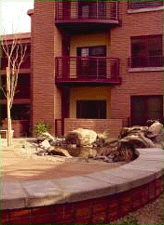Choosing the Right Mortar
By Jamie Farny
 With so many varieties of masonry units to pick from, it might be easy to forget about the mortar. But choosing mortar is just as important as choosing masonry units. Mortar accounts for up to 17% of the wall. Fortunately, designating a mortar is straightforward. The compressive strength of the wall determines what strength of mortar will be required, and the wall's desired appearance determines the mortar's aesthetics.
With so many varieties of masonry units to pick from, it might be easy to forget about the mortar. But choosing mortar is just as important as choosing masonry units. Mortar accounts for up to 17% of the wall. Fortunately, designating a mortar is straightforward. The compressive strength of the wall determines what strength of mortar will be required, and the wall's desired appearance determines the mortar's aesthetics.
What Mortar Does
Mortar joins masonry units into an integral structure with predictable performance properties. To be successful, mortar must also satisfy other requirements:
- Create tight seals to keep out air and moisture.
- Bond with reinforcement such as ties, anchor bolts or joint reinforcement (if present).
- Accommodate tolerances in masonry units.
A large number of masonry walls utilize masonry as an architectural veneer; the structural frame carries the loads. In this case, the masonry acts as a weather barrier and an aesthetic finish, but not as a structural component. Of course, there are walls made of structural masonry, and in this case, the mortar has more rigorous strength requirements that it must fulfill.
Mortar Materials
Masonry mortar is composed of one or more cementitious materials; clean, well-graded masonry sand; and sufficient water to produce a plastic, workable mixture. Modern specifications call for proportions by volume ranging from one part of cementitious material to 2-1/4 to 3-1/2 parts of damp, loose mortar sand.
There are several types of cementitious materials, or binders, that can be used to make masonry mortar: Portland or blended cement with lime, masonry cement and mortar cement. The choice of cementitious material is largely a matter of economics and convenience. The most common mortar binder in the U.S. is masonry cement because it is easy to use and gives consistent performance. At the job site, this translates to uniform mortar from batch to batch. Colored masonry cements are available to make colored mortar, and masonry cement also simplifies achieving uniformity in color.
No matter which binder is chosen, mortar is specified according to type. The document that guides specifiers on choosing mortar is ASTM C 270, Standard Specification for Mortar for Unit Masonry. Specifiers can choose one method of designating mortar composition: by proportions (selecting a "recipe") or by property (selecting the performance desired). Either way, the mortar is designated by a letter.
On new work, Types N, S or M are used. Type N is the most common type and it is designated "normal" strength. Unless there is a compelling reason to choose otherwise, like a severe exposure or a structural requirement, Type N should be used. Mortars of moderate, or normal, strength provide an optimum balance of workability, strength and watertightness.
About the Author
Jamie Farny is the Program Manager of Masonry and Special Products for the Portland Cement Association, coordinating research and promotion activities regarding cements for masonry and white cement. He participates on committees on concrete, plastering, mortars, and masonry units of the American Society for Testing and Materials and the American Concrete Institute. He holds a B.S. in Civil Engineering from the Illinois Institute of Technology.


















